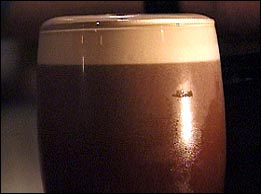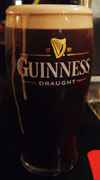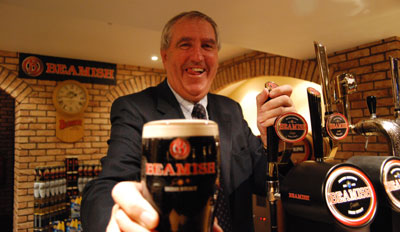Bad pint/Good pint – rules for finding the perfect pint in Ireland
 This is something that is of grave and serious concern in Ireland: the quality of one’s pint.
This is something that is of grave and serious concern in Ireland: the quality of one’s pint.
Arguments are started, families have been split and lives have been formed around the difference between a pint served in one place and the pint served in another. It can be argued sensibly that there are, of course, some places where you’re guaranteed a bad pint, but there are also places where the opposite is true. To your average Irish punter, it makes complete sense that beer distributors (well, some of them) spend a huge amount of money checking every single venue where their beer is served throughout Ireland to ensure consistency.
Before moving to Ireland, I really thought that this was a myth. If you have ever been with an Irishman (or woman) stateside when they’re ordering a pint of stout you may have seen them refuse a pint because it was not allowed to settle before being served to them.
I myself have seen the dumbfounded shock and horror firsthand on an Irishman’s face when he ordered a Guinness stateside and the bartender placed a non-tulip glass on the drain under the tap, hit the handle to dispense, walked away, returned as it was overflowing and then simply wiped the spill off the outside of the glass with a bar towel before serving it to him.
Here in Ireland This. Is. Simply. Not. Done.
 Never ever ever ever infinity. So, given the seriousness with which the pour is taken, imagine the seriousness with which the taste is taken into account. Now, I consider myself a bit of a beer nerd. I love a good pint of stout and had certainly noticed a difference between the Guinness at home and the Guinness in Ireland, but chalked it up to the fact that drinking in Ireland makes everything seem better.
Never ever ever ever infinity. So, given the seriousness with which the pour is taken, imagine the seriousness with which the taste is taken into account. Now, I consider myself a bit of a beer nerd. I love a good pint of stout and had certainly noticed a difference between the Guinness at home and the Guinness in Ireland, but chalked it up to the fact that drinking in Ireland makes everything seem better.
Well, it turns out that the difference has at least one concrete reason: Guinness served in Ireland is NOT PASTURISED. That’s right, it’s served fresh. And, due to the lack of pasturisation, if that beer isn’t consumed promptly, it could very well go bad.
There are many other factors, of course – the age and cleanliness of the pipes used, how many twists those pipes make, the way the glasses are washed, the state of the gas lines (draught Guinness uses Co2 and nitrogen), the temperature of the cold room, the temperature of the room you’re in . . . everything down to whether you’ve brushed your teeth recently, the amount of moisture in the air, or whether the barrel of beer is full, close to empty or somewhere in between.
So, how do you find a good pint? Well, after countless hours of tireless research and without getting too niggly on the details, may I present the following guide to locating a good pint of stout in Ireland:
1. Look to see if anyone else is drinking it. Chances are if they aren’t, you shouldn’t.
2. Look for old men. If there’s a crowd of old men in the bar, it may be a good sign. Those fellas have been around and know where the good pint is. Chances are they’re pensioners as well and those taps may have been flowing since early that morning – meaning a fresh pint is just waiting at the tap.
3. Look for a branded service van out front. Not the delivery, but the smaller service vans mean that the pipes may being cleaned. If the pipes are being cleaned or have just been cleaned, a lot of folks would say the pints don’t taste right until the beer has been flowing through it for a day or more – it’s best to move on.
4. Sticky stout head. If you see people drinking stout around you, look to see if the creamy head is sticking to the sides of their glass or not. If it’s not, either the beer is at the wrong temperature or, more likely, the glass is dirty.
 5. The right glass. See if the beer on the tables is being served in the right glass. If you see stout in a pilsner glass, it’s a sign that the barstaff aren’t paying too much attention. Beer companies spend a lot of money designing the right glass for their beer for more than appearance reasons – it really does affect the drink. If you see the Bulmer’s logo sitting in front of a black pint of Guinness it might be better to give this pub a miss.
5. The right glass. See if the beer on the tables is being served in the right glass. If you see stout in a pilsner glass, it’s a sign that the barstaff aren’t paying too much attention. Beer companies spend a lot of money designing the right glass for their beer for more than appearance reasons – it really does affect the drink. If you see the Bulmer’s logo sitting in front of a black pint of Guinness it might be better to give this pub a miss.
6. Empty pub in the morning. Ever notice how when the beer tap is pulled, the beer just magically flows immediately? Well, that means that the first pint (or the first several pints) the bar pulls in the morning has been sitting in the pipes since the night before – not the optimal situation. If you seem to be the first customer of the day/evening, maybe have a cup of tea until a few pints have been poured around you.
Of course, these rules are meant as general guidelines and not absolutes. I’d love to hear any other guidelines folks might have for finding a decent pint – I’m sure there’s loads out there.